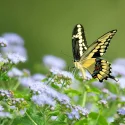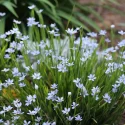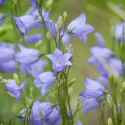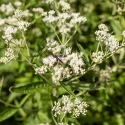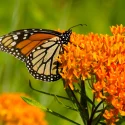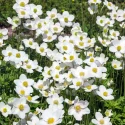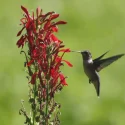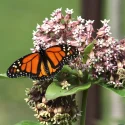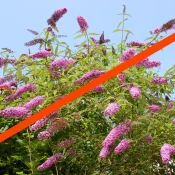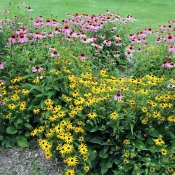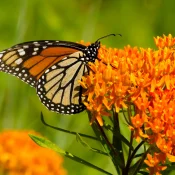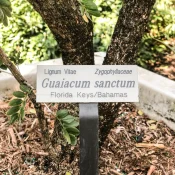Native Black-Eyed Susans: A Beginner’s Guide
Black-Eyed Susans are resilient native flowers that bloom at the end of summer into the fall. They thrive in full sun, part sun, and drought. After they flower, their seedheads become food for birds. They will come back year after year if perennial or via reseeding itself. Put the unfortunate common name aside (why does Susan have black eyes?!) and celebrate these native plants’ resilience and beauty. Scroll on to meet a few native options.
- Full Sun, Part Sun
- Height depends on species
- Summer flowers
- Easy to find
Black-Eyed Susans are super easy to grow
What are the benefits of planting Black-Eyed Susans?
Planting native plants makes our yards and spaces gorgeous while helping the birds, butterflies, and animals (and helping save us time!) Here are three reasons why planting Black-Eyed Susans are worth it:
- Help pollinators. Without native plants like this flower, iconic animals like Monarch butterflies and songbirds won’t have the food or homes needed to survive.
- Save time and money: after the first year of getting established, most native plants are happy with rain.
- Black-Eyed Susans are DEER-RESISTANT.
- Long-time blooms. Black-Eyed Susans bloom for 4-6 weeks at the height of the hot summer. And many native species come back year after year.
All Black-Eyed Susans are native to North America
These beautiful plants typically belong to the Rudbeckia genus. Native plants often have two types of names: common names and Latin names. Common names, like Black-Eyed Susan, come from earlier generations (especially European colonists). The two-part Latin names include the plant’s genus and species.
A few species of flowers are known as “Black-Eyed Susan.” Latin names are a big help when determining whether you’re looking at the right plant.
Rudbeckia = Black-Eyed Susan = native plant
Next time you’re at a nursery or plant sale, look for the Latin name on the tag. If you spot ‘Rudbeckia,’ you’ve found a native gem. Plant it with confidence, knowing it’s ideally suited for our North American landscapes.
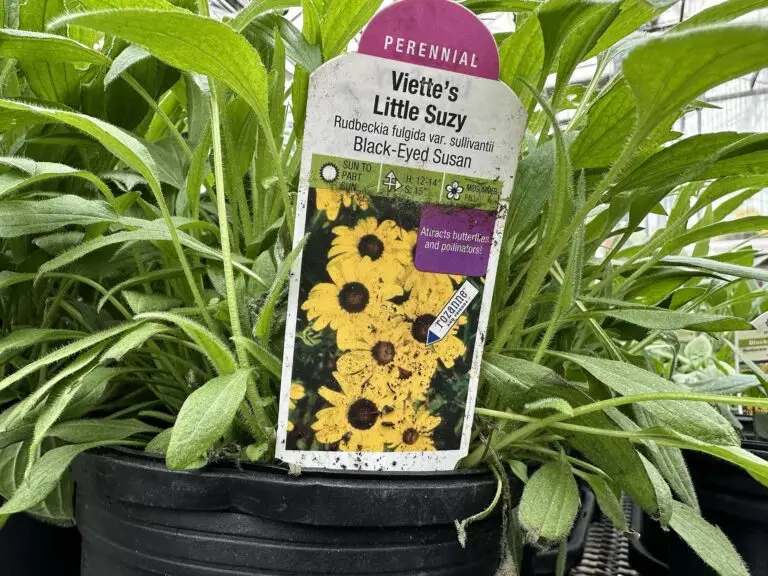
Now that we’ve introduced both the Latin name and common name, you are probably asking:
Where did the name Black-Eyed Susan come from?
As you probably guessed with an eye roll: the common name comes from a man writing about a sad lady. (It’s just as cheesy as you think it is.)
The sad song of Black-Eyed Susan
According to Texas Park & Wildlife, “the flower’s name likely comes from a popular ballad penned by English poet John Gay (1685-1732). Black-Eyed Susan told the sad story of a crying, lovelorn woman who boards a ship to bid her sailor farewell.”
Womp womp. Here’s the song sung by Patricia Hammond, if you’d like to hear it.
What a bummer that a weepy European dude named such a stellar, bright, resilient plant. It’s a true disservice to a plant that does not have a black center (it’s dark brown) and thrives in some tough-as-nails situations.
But common names can change! Let’s see if we can change this one’s common name in our lifetimes. Maybe we can change it to ‘Resilient Susan‘?
Read our round-up of Terrible Names for Beautiful Native Plants for more examples of bad plant copywriters. Now that we brought up names, you might be asking…
Where does the name Rudbeckia come from?
The Latin name also has a European backstory. As mentioned, the Latin genus name of these native plants is Rudbeckia. According to Texas Park & Wildlife, “Caroleus Linnaeus, the ‘father of modern botany,’ named the flower’s genus for his esteemed professor, Swedish botanist Olaf Rudbeck.”
Sigh. More native plants named after actual living women and notable North Americans, please.
Let’s put all that aside and talk about why this plant—whatever you want to call it–is a must for your garden.

There are a few species of Black-Eyed Susan to consider
Within the Rudbeckia genus there are a few native options. Making it even more confusing, many are referred to as “Black-Eyed Susan,” which is why the Latin names can be such a great help!
Some species commonly found at plant nurseries include:
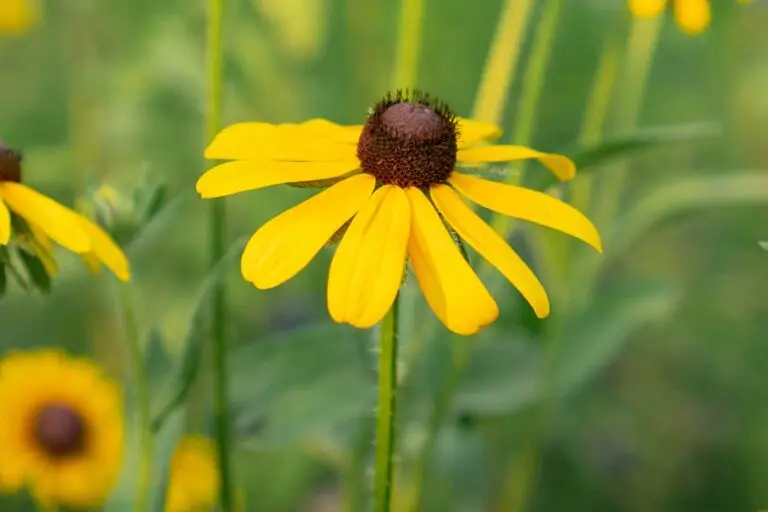
Black-Eyed Susan
Rudbeckia hirta
This black-eyed susan is a knockout for gardens, known for its bright yellow petals and dark brown central cone. It is a short-lived perennial (1-2 years) but will easily reseed itself.
R. Hirta is easily identified by the short hairs on its stems and leaves. It ranges in height from 1 to 3′ and has bigger (but a little more sparse) flowers than R. fulgida.
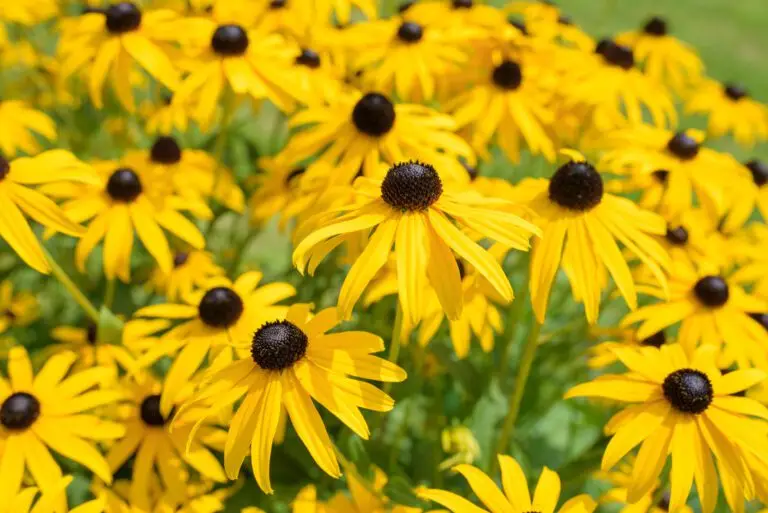
Black-Eyed Susan or Orange Coneflower
Rudbeckia fulgida
Similar to R. hirta, this species features bright orange-yellow flowers with a dark center. This plant is more dependably a perennial—meaning it will return year after year. R. fulgida has smaller but more numerous flowers than R. hirta. It has hairs on its stem and leaves too, but they are tiny compared to R. hirta.
Although it is sometimes called ‘Orange Coneflower,’ most coneflowers are in the Echnicaea genus. Our Beginner’s Guide to Coneflowers is perfect for more info.
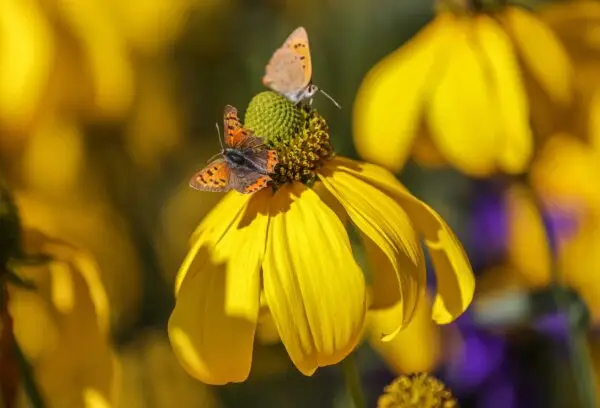
Black-Eyed Susan or Cutleaf Coneflower
Rudbeckia laciniata
This plant is easily recognizable by its deeply lobed leaves and tall stature.
These plants are TALL—reaching heights of up to 9 feet. The flowers are yellow with greenish centers, and it is commonly found in moist meadows and along stream banks.
And there’s more…
These are just a few Rudbeckia options. The genus has around 25 species, each native to North America.
As you explore Black-Eyed Susans, you will encounter some plant options with cheeky names in ‘single quotes,’ like ‘Indian Summer’ or ‘Goldsturm.’
These are Black-Eyed Susan cultivars.
Black-Eyed Susan cultivars
A cultivar is a plant curated by humans to look or behave a certain way (here’s our quick cultivar overview.) There are dozens of Black-Eyed Susan cultivars available, including:
- R. hirta ‘Indian Summer’ This cultivar is renowned for its large, golden-yellow flowers that can reach up to 9 inches in diameter. It is a robust and vigorous plant, often used in borders and as cut flowers due to its striking appearance and long blooming period.
- R. fulgida ‘Goldsturm’ The ‘Goldsturm’ cultivar is a version of Rudbeckia fulgida, bred for an abundance of flowers and heat tolerance. This combination has made it a staple in perennial gardens.
- R. hirta ‘Toto’ This dwarf variety is perfect for small gardens and containers. ‘Toto’ has a compact shape and piles of bright yellow flowers with dark centers. It is known for its neat, tidy appearance and long-lasting blooms.
That said—we have an opinion when it comes to cultivars. We even made up a silly rhyme to help remember:
Local blooms, fewer glooms
Find native plants near you
Local plants and seeds—grown within 800 miles—are best suited for your garden. This also fosters cross-pollination among locally grown plants, enhancing their resilience for generations to come. Stay local for a happy garden!
Black-Eyed Susan is deer-proof
Deer do NOT eat Black-Eyed Susans. If you’re worried about deer nibbling your garden, planting Black-Eyed Susans are a good native gardening choice.
How to grow Black-Eyed Susans
Black-eyed Susans are an incredibly easy plant to grow and enjoy. Black-eyed Susans like lots of different sun situations—from full, blazing sun to part-sun. They also are happy in a range of water situations, from super-dry to sometimes-wet.
Grow Black-Eyed Susans from seed
Growing Black-eyed Susans from seed is easy if you’re patient: plants started from seed will not flower until the next year. This is because in the first year, the plant puts all its energy into growing its root system, which is also what makes the plant drought-tolerant. To grow from seed, you can either start in small pots in early spring and then replant in the garden, or you can directly sow the seeds.
If you get seeds from a friend's garden...
Black-eyed Susan seeds taken from another garden will need to be cold for ~1-3 months before they will grow. The need to be cold before growing is called stratification. Stratification is a part of many seeds that grow in places that experience frosts. A seed knows to stay dormant after it’s cold for a period of time before it sprouts.
You can trick seeds into breaking their dormancy by using a refrigerator or by putting them in a cold, dry place (like a basement or garage). Simply place seeds in a water-tight container and put them in this cold storage for 1-3 months. Take them out and they’ll be ready for growing.
Don’t worry about seeds you buy from a nursery or mail-order: these seeds have already been refrigerated and are ready to go.
How to start seeds in the spring
Black-Eyed Susan seeds can be started indoors in the spring and then planted out in the garden in the late spring/early summer. This is a cheap way to grow lots of plants; a $5 packet of seeds (or a single seedhead from someone’s garden) can grow dozens of plants.
There are lots of ways to start seeds inside, whether using plastic trays and heating mats or simply using washed-out yogurt containers on windowsills. (Native plants literally plant themselves in nature—they don’t need fancy equipment!)
- Pick an airy soil mixture to help the seeds find light and air
- Plant each Black-Eyed Susan seed 1/4″ beneath the soil
- Keep the soil moist but not too wet; a spray bottle can help at the beginning
- Sprouts will emerge after a week of planting
- Transplant when there are at least two rows of leaves on the plant and the nighttime temperatures average 60 degrees.
How to grow from seed in the fall
Growing Black-Eyed Susans by seed in the fall is an easy planting trick. Seeds planted in the fall will not sprout and grow until the spring, but planting in the fall will ensure the plants sprout and grow naturally based on the soil and air temperatures. You can literally sprinkle the seeds in the fall and forget about it until spring, then enjoy plants in the summer.
- Clear an area of leaves, mulch, or rocks using a rake
- Get a packet of seeds or a seedhead from another’s garden
- Sprinkle the seeds on top of the cleared ground; it’s ok to sprinkle quite a few—some seeds will be eaten by birds
- Lightly cover the seeds with soil
- Wait until the spring!


Plant Black-Eyed Susans from plants
There are four tried-and-true ways to find (or buy) Black-Eyed Susan plants for your garden:
Where can I find seeds and plants?
Finding native plants can be challenging (we partly blame Marie Antoinette.) To make it easier, we’ve assembled four sourcing ideas.
Native Nursery List
300+ native nurseries makes finding one a breeze
Online Native Plant Sellers
We've included 100+ online resources to help
Society Plant Sales
Every state has a native plant society; find yours
Online Communities
Local Facebook groups are a great plant source
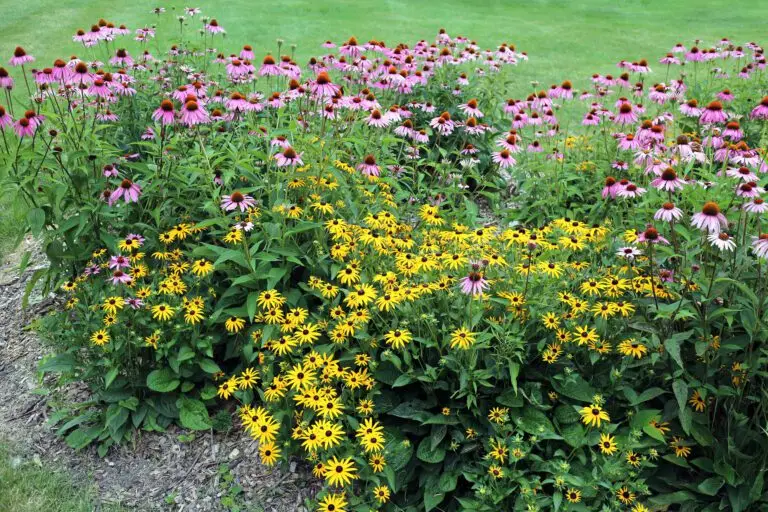
What pairs well with Black-Eyed Susans?
Black-Eyed Susans have lots of plant friends that thrive in similar light/water and look amazing alongside them. A great way to pick flowers is to ensure you’ve got blooms throughout the season, from spring to fall. Here are some options:
Native flowers for spring
Other native plants for the summer
Native plants for fall
In conclusion, Black-Eyed Susans are a must-have addition to any garden. With their bright, sunny blooms, super-easy care, and benefits to wildlife, it’s no wonder that these native North American plants are favorites among gardeners. Black-Eyed Susans are a top choice if you’re looking to add some color to your landscape, attract pollinators, or enjoy their sunny nature. Can we suggest visiting our Beautiful Native Plants with Terrible Names to find more inspiration? Happy planting!
Sources
- Blue Water Baltimore. “How to Choose a Black-Eyed Susan.” Blue Water Baltimore. Accessed July 21, 2024.
- Yonge, Charlotte Mary. Sweet William. London: National Society’s Depository, 1882. https://archive.org/details/SweetWilliam55271/page/n1/mode/2up.
- Royle, Stanley. Honeysuckle and Sweet Peas. Oil on canvas. Yale Center for British Art.
- Unknown artist. Portrait of Olof Rudbeck the Elder. Wikimedia Commons.
- Lang, Kristine. “Rudbeckia: Brighten the Garden from Summer through Fall.” South Dakota State University Extension. September 03, 2021.
- Paddock, George E. “Lophophora Williamsii: Its Habitats, Characteristics and Uses.” Bulletin of the Lloyd Library of Botany, Pharmacy and Materia Medica 11, no. 3 (1909): 405.
- Wikipedia. “Rudbeckia.” Wikipedia, The Free Encyclopedia. Last modified July 8, 2023.





















